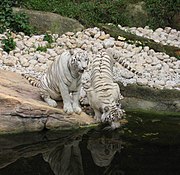

Cockroaches live in a wide range of environments around the world. Pest species of cockroaches adapt readily to a variety of environments, but prefer warm conditions found within buildings. Many tropical species prefer even warmer environments and do not fare well in the average household.
Cockroaches leave chemical trails in their feces as well as emitting airborne pheromones for swarming and mating. Other cockroaches will follow these trails to discover sources of food and water, and also discover where other cockroaches are hiding. Thus, cockroaches can exhibit emergent behavior, in which group or swarm behavior emerges from a simple set of individual interactions.
Research has shown that group-based decision-making is responsible for complex behavior such as resource allocation. In a study where 50 cockroaches were placed in a dish with three shelters with a capacity for 40 insects in each, the insects arranged themselves in two shelters with 25 insects in each, leaving the third shelter empty. When the capacity of the shelters was increased to more than 50 insects per shelter, all of the cockroaches arranged themselves in one shelter. Researchers found a balance between cooperation and competition exists in group decision-making behavior found in cockroaches. The models used in this research can also explain the group dynamics of other insects and animals.
Cockroaches are mainly nocturnal and will run away when exposed to light. A peculiar exception is the Asian cockroach, which is attracted to light. Another study tested the hypothesis that cockroaches use just two pieces of information to decide where to go under those conditions: how dark it is and how many of their friends are there. The study conducted by José Halloy and colleagues at the Free University of Brussels and other European institutions created a set of tiny robots that to the roaches appear to be other roaches and can thus alter the roaches' perception of critical mass. The robots were also specially scented so that they would be accepted by the real roaches.
Additionally, researchers at Tohoku University engaged in a Classical Conditioning experiment with cockroaches and discovered that the insects were able to associate the scent of vanilla and peppermint with a sugar treat.
























